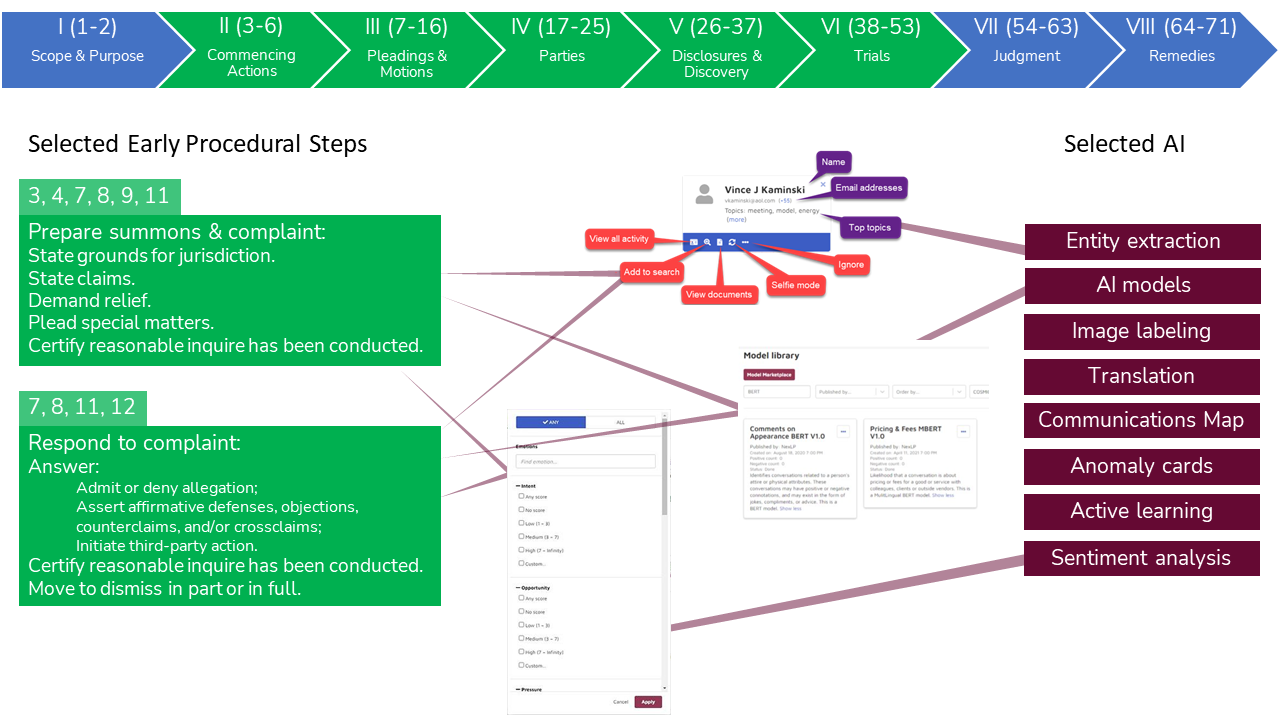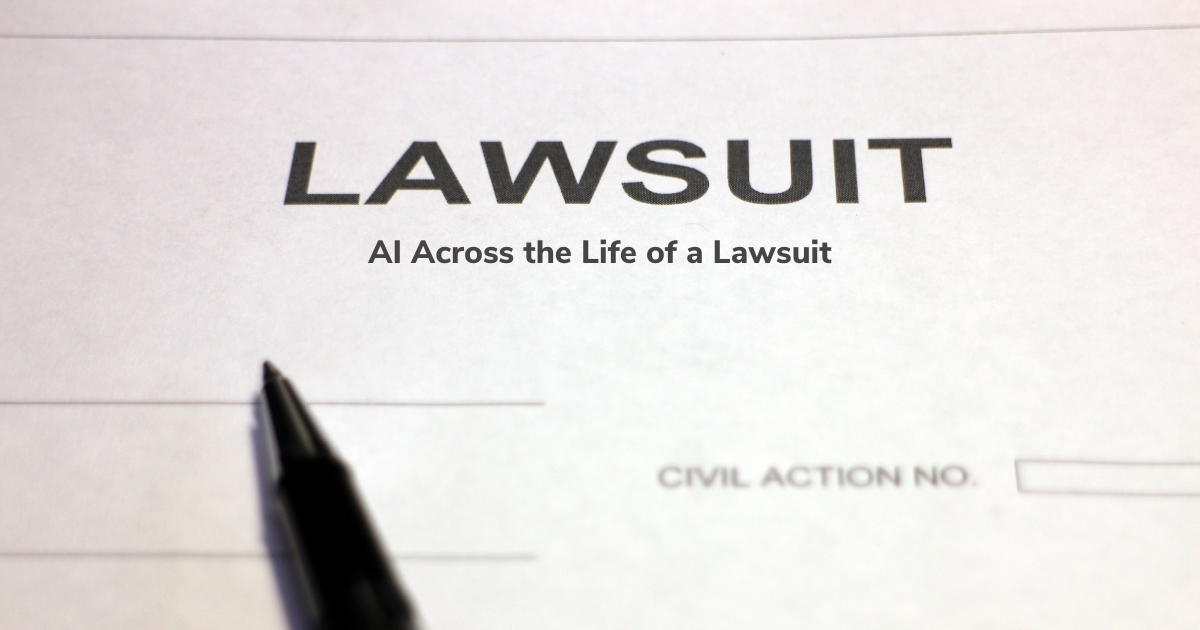AI Across the Life of a Lawsuit
This post is the first in a series looking at how to use artificial intelligence tools across the full life of a lawsuit.
Today, if we use AI technology on our cases at all, we tend to deploy those capabilities - machine learning, AI algorithms, AI-based automation, and the like - primarily for a narrow range of activities. We use them mostly to identify (a) relevant content and (b) content that might be privileged or subject to some other form of protection. When we narrow our use of AI systems in that way, however, we overlook potent possibilities.
We can use those same technologies to great effect across the entire life of a lawsuit. Starting before the initial complaint is drafted and continuing all the way to final resolution and data clean-up, we can turn to communications analysis, image mapping, translation, transcription, active learning, and other AI-driven capabilities to help us get our work done faster, better, and even less expensively.
To accomplish this, it helps to have an overarching framework against which we can map our use of these capabilities. We have just such a framework ready and waiting for us, only that has benefited from nearly a century of development and refinement: the Federal Rules of Civil Procedure.
As a law student, I never understood the importance of procedural rules. Only as a practicing attorney at a law firm did I come to appreciate that they provide us with a road map for navigating lawsuits. Not only do these rules guide us as we work up matters as lawyers. Those rules provide us, as well, with a template for where to more effectively use AI systems.
The Litigation Life Cycle
Lawsuits follow predictable life cycles. They start with a potential plaintiff (or plaintiffs). They end with a dismissal, settlement, or judgment. In between, they take a more or less regular path. In the US, this typically includes preparing pleadings, making motions, interviewing witnesses, preserving and working with electronically stored information, conducting formal discovery, negotiating with opposing counsel, and the like.
There is no need to attempt to build this life cycle from scratch. We already have well-established litigation life cycle roadmaps. In US Federal courts, we rely on the Federal Rules of Civil Procedure along with the Federal Rules of Evidence. In state courts, we turn to state civil procedural rules and state evidentiary rules. Canadian jurisdictions have their procedural rules, such as the Rules of Civil Procedure set forth in Ontario's Courts of Justice Act. The United Kingdom has its Civil Procedure Rules and Practice Directions, Australia its Federal Court Rules, Singapore its Rules of Court and Practice Directions, and so on.
The FRCP's Litigation Life Cycle
Dating to 1938 and promulgated pursuant to section 2072 of Title 28, United States Code, the Federal Rules of Civil Procedure are "general rules of practice and procedure...." They "govern the procedure in all civil actions and proceedings in the United States district courts, except as stated in Rule 81," per FRCP Rule 1.

The Rules are organized into eleven groups, or Titles. Perusing title names, you can see they are arranged to step attorneys through cases, beginning with the commencement of an action and continuing through judgment and remedies. The titles are:
-
- Title I. Scope of Rules; Form of Action (Rules 1 - 2)
- Title II. Commencing an Action; Service of Process, Pleadings, Motions, and Orders (Rules 3 - 6)
- Title III. Pleadings and Motions (Rules 7 - 16)
- Title IV. Parties (Rules 17 - 25)
- Title V. Disclosure and Discovery (Rules 26 - 37)
- Title VI. Trials (Rules 38 - 53)
- Title VII. Judgment (Rules 54 - 63)
- Title VIII. Provisional and Final Remedies (Rules 64 - 71)
- Title IX. Special Proceedings (Rules 71.1 - 76)
- Title X. District Courts and Clerks: Conducting Business; Issuing Orders (Rules 77 - 80)
- Title XI. General Provisions (Rules 1 - 86)
- XII. Appendix of Forms
- XIII. Supplemental Rules for Admiralty or Maritime Claims and Asset Forfeiture Actions (Rules A - G)
Far from static, the Rules have been amended at least 38 times. Most notable for eDiscovery practitioners, the rules were amended in 2006 and again in 2015 specifically to address challenges poses by electronically stored information.
Most discussions about how to make good use of eDiscovery technology, including the use of AI, tend to center on a small number of rules.

Principle among these rules are:
-
- Rule 16. Pretrial Conferences; Scheduling; Management: In particular, 16(a) pretrial conferences and the 16(b) scheduling order.
- Rule 26. Duty to Disclose; General Provisions Governing Discovery: Especially the 26(a)(1) initial disclosure and the 26(b)(1) proportionality test.
- Rule 34. Producing Documents, Electronically Stored Information, and Tangible Things, or Entering onto Land, for Inspection and Other Purposes: Notably 34(a)(1)(A) requests for production of documents and ESI and 34(b)(1)(C) form or forms of production.
- Rule 37. Failure to Make Disclosures or to Cooperate in Discovery; Sanctions: 37(e) sanctions for failing to take reasonable steps to preserve electronically stored information (ESI).
As is evident from the above, there is a lot more to handling a lawsuit than asking for and producing ESI. And there is a lot that can be done with AI in that broader range of activities.
Discovery and eDiscovery
To better explore how we can use AI tools in areas beyond discovery, it may help to first consider how those tools are used for eDiscovery. And for that, it can useful to start with discovery itself.
At a basic level, discovery consists of:
-
- Identifying information that might help bring a matter to resolution;
- Gathering that information, which sometimes also entails preserving it;
- Possibly taking steps to make the information easier to work with;
- Evaluating the information, for example to test the viability of the lawsuit;
- Reviewing a portion of the information for specific purposes such as locating relevant content or finding privileged or protected content; and
- Producing a subset of the information to opposing counsel.
The information worked with as part of discovery comes from four sources:
-
- We gather information from people's heads. We might have a discussion, conduct a more formal interview, or take their testimony at a deposition, during a hearing, as part of an arbitration, or at trial.
- We look at paper, historically a major source of information in lawsuits but these days there is comparatively little paper for us to consider.
- Sometimes we examine tangible objects, a football helmet, for example, or the braking system on a motorcycle.
- We get information that has been stored electronically, or electronically stored information (ESI). Even in a small case, we might encounter a million electronic files or more.
When discovery involves ESI, that is what we generally consider to be electronic discovery, or eDiscovery.
To work with ESI, we have access to an increasingly sophisticated and powerful arsenal of tools. To search data, initially we relied on simple text searches, such as "socha". We quickly moved to Boolean searching, which offered greater power and nuance. I could search for "george AND socha", "george w/5 socha", "george w/5 socha BUT NOT (senior OR sr)", and so on.
AI Technology in eDiscovery
Today, we can turn to artificial intelligence to help with our decision-making processes. Early on, one AI technology dominated: supervised machine learning. Initially we called it "Predictive Coding". When a provider trademarked that phrase, the industry moved to "technology assisted review" or TAR. Folks argued - and continue to argue - about whether predictive coding and TAR are the same or different. Some assert that any use of technology to assist with review is TAR - they would include using Boolean searching as TAR - and agitate for a different phrase. We have discussions, sometimes fights, over what terms to use or avoid: TAR 1.0, TAR 2.0 - I have heard up to TAR 6.0; active learning; continuous active learning (CAL); and so on.
We also have unsupervised machine learning capabilities, less discussed that supervises ones but for many purposes far more powerful. These include entity extraction, image labeling, sentiment analysis, transcription, translation, and more. Using these AI technologies, you might be able to find content to, from, or about me that you probably never would locate using search terms. Searches might return email messages I sent from "fencer1975@aol.com", pictures of me after a race, communications in French containing highly useful discussions, statements I made at a recorded event.
AI and the Rules
Returning to the Rules, we can ask ourselves where might AI fit. We find, if we point an "artificial intelligence" eye at the Rules, that AI potentially can help from before a complaint is filed all the way to the conclusion of trial.
The diagram below highlights a few examples of where AI can bring value on the onset of a lawsuit, at a time when you are only just beginning to understand what the case might be about. As soon as you begin to gather or receive data, you can start analyzing it. With entity extraction and tools built on that capability, you can look more closely at potentially important people, learning more about the email addresses and pseudonyms they used, the positions they held, the concepts the discussed in their communications, the people the communicated with. With AI models, especially ones built using BERT or MBERT, you can a jump start on located data that you might want to examine more closely, or that you may prefer to set aide. You can draw on sentiment analysis, exploring not just what people say but the emotional intelligence in those communications. And as you gain a better sense of what the lawsuit may be about, you can begin to search for potentially relevant data.

What's Next
In coming posts, we will dive into the Rules, discussing how targeted use of AI applications can help you most your cases more effectively from before the initial complaint has been drafted and continuing all the way to final resolution and data clean-up.
If your organization is interested in learning more about making more effective use of AI across the life if a lawsuit and how Reveal uses AI as an integral part of its AI-powered end-to-end legal document review platform, contact us

